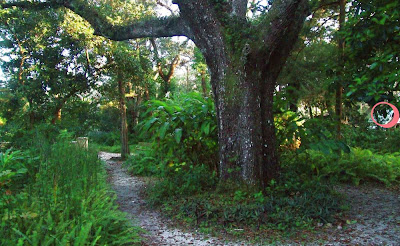1. When seen against the skyline, leaves are always darker than the background.
2. When seen below the skyline, leaves in a natural setting are always lighter than their surroundings.
 The "skyline" is the line of the top of the trees against the sky. Here's an example of Rule 1, which is not surprising.
The "skyline" is the line of the top of the trees against the sky. Here's an example of Rule 1, which is not surprising. The second law may come as a surprise, because we always tend to think of leaves as dark silhouettes, and we tend to paint them that way. But in a natural setting, whenever you see any leaf against any background below the sky, chances are that nearly every single leaf is lighter than what is behind it.
The second law may come as a surprise, because we always tend to think of leaves as dark silhouettes, and we tend to paint them that way. But in a natural setting, whenever you see any leaf against any background below the sky, chances are that nearly every single leaf is lighter than what is behind it. The exceptions to Rule #1 are so rare that they are momentary and breathtaking. Here’s a shot of a Rule 1 exception, taken from a fast-moving car when the late afternoon light penetrated beneath a deck of stormclouds. The effect only lasted five minutes. It can be very exciting to break this rule, but all the conditions should be carefully observed.
The exceptions to Rule #1 are so rare that they are momentary and breathtaking. Here’s a shot of a Rule 1 exception, taken from a fast-moving car when the late afternoon light penetrated beneath a deck of stormclouds. The effect only lasted five minutes. It can be very exciting to break this rule, but all the conditions should be carefully observed. The exceptions to Rule #2 (pink circle at right) happen a little more often, but usually only when leaves are seen against human interventions, like lawns, walls, or cleared areas. If you walk around in a forest or a meadow, the leaves are almost always lighter than what’s around them.
The exceptions to Rule #2 (pink circle at right) happen a little more often, but usually only when leaves are seen against human interventions, like lawns, walls, or cleared areas. If you walk around in a forest or a meadow, the leaves are almost always lighter than what’s around them.I assume that Rule #2 happens because of the light-seeking nature of leaves. They are little machines that are superb at angling for the best position to capture the most light.







9 comments:
Great information! Gracias
I don't know about that. Exceptions are more numerous than one might think. As I was driving this afternoon, I noticed a slight breeze at the top of trees turned them making their back sides visible, lighter than the surrounding sky. Then on side of the sun, the light itself was shining through the leaves making them lighter than the sky. So I'd take several exceptions to Rule #1.
So, below the sky, the leaves(trees) are mostly lighter than their surroundings. Is it correct to say that they(trees) will be darker than the ground, because the light hits the ground at a flatter angle? I always heard that that was the rule, but I never heard anything about trees being lighter than everything else except the ground. Really good information.
Christine, I'm mainly talking about individual leaves against their surroundings, not entire trees. Trees will often register pretty dark, especially against cut grass or other man-made environments, but if you walk around in nature and look at individual leaves against any background but the sky, most all of them will be light on dark.
Dianne, thanks for listing those perceptive exceptions to Rule 1. Willow leaves, or light autumn leaves, transmitted light, or bright highlights are often lighter than the sky color. But compared to the vast number of leaves that are dark against the sky, in my experience, these exceptions are still in the minority.
Exceedingly helpful! I am slowly venturing into natural landscapes, and your analysis really pointed out aspects of seeing that may have remained unconscious and accidently correct.
Thanks! Lucidity is so much better.
The second law is interesting. First I thought it may be because leaves are semi-transparent, but your observation of how they reflect light is probably true.
Another exception to the second rule could be atmospheric perspective, for instance on a foggy day.
great blog, keep rocking it.
f.
That's a helpful rule of thumb to remember.
You know everything.
(Thanks for sharing it!)
I was looking at trees outside today, remembering this post. It is all true!
Okay, landscape painters: here's a question I always had. What colors do you use in tree trunks. First instinct is to reach for that brown, but when I look at trunks, they don't look brown at all!
Answer this question and I just may set aside my cartoons long enough to paint a tree.
Post a Comment